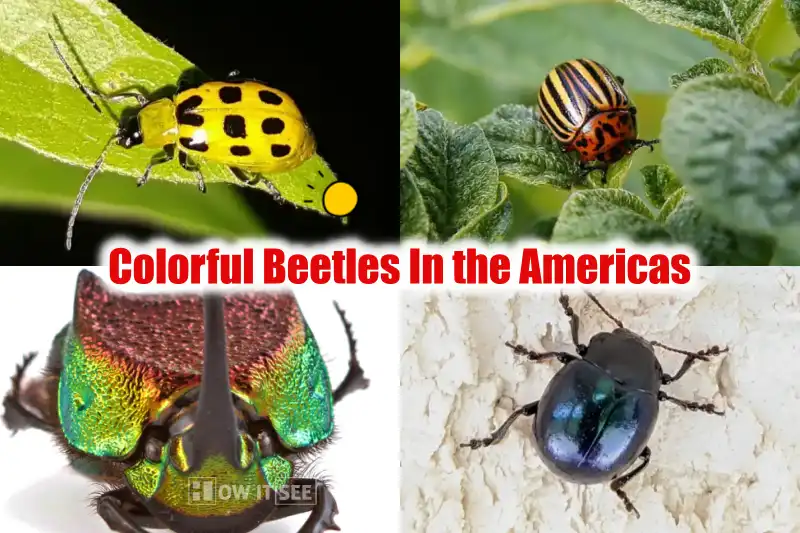In the world of insects, beetles are the ones who shine brightly with their remarkable and vibrant colors. Most of us know there are a lot of beetle species, and we can’t cover all of them, so we are choosing a continent. That’s known other than in America. So here we are going to look at some of the colorful beetles that are native to America.
Let’s go on a journey to explore the beautiful and diversified world of these colorful beetles.
15 Colorful Beetles In the Americas
1. Rainbow scarab

| Scientific name | Phanaeus vindex |
| Size | 25-50 mm |
| Identification | metallic yellow head |
| Geographical location | Central United States, Florida, New England, Arizona, Wyoming, and Mexico |
Phanaeus vindex is a North American species of true dung beetle found in the eastern and central United States, including Florida, New England, Arizona, Wyoming, and Mexico.
It is the most widespread species of Phanaeus in the US and has a wide habitat tolerance. The beetle has a metallic yellow head, black horn, yellow antennae, and a metallic green abdomen.
Males have a large-bodied and large-horned “major” morph and a smaller-bodied and smaller-horned minor morph. It may hybridize with the less common P. difformis.
2. Fiery searcher
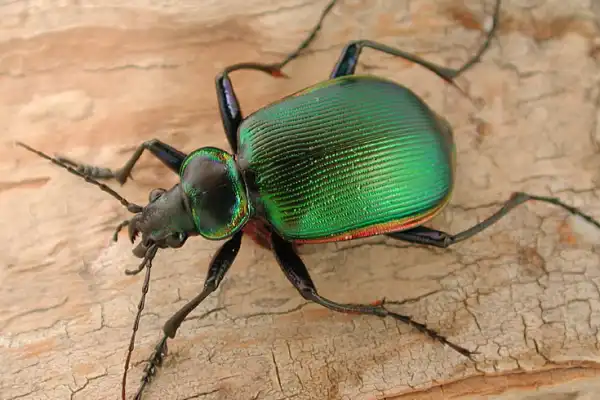
| Scientific name | Calosoma scrutator |
| Size | ~35 mm |
| Identification | Metalic green thorax |
| Geographical location | North America |
Calosoma scrutator, also known as the fiery searcher and caterpillar hunter, is a ground beetle species in the genus Calosoma, subgenus Acalosoma. It can grow up to 35 millimeters long and is common in North America.
The adult beetle excretes a foul-smelling oil when handled, resembling rotten milk or rancid olive oil. The blackish-purple beetle has a green thorax and is about 1 inch long. Its eggs are whitish and laid in the soil.
The larvae are yellowish-gray to white and have sharp jaws. Adults are shiny, metallic, and have a metallic gleam. Females lay fertilized eggs in soil, and hatched larvae pupate in soil cells. Adults can live up to 3 years.
3. Colorado potato beetle

| Scientific name | Leptinotarsa decemlineata |
| Size | ~15 mm |
| Identification | orange-yellow body with 10 black stripes on their elytra |
| Geographical location | The Rocky Mountains range in America |
The Colorado potato beetle, also known as the Colorado beetle, ten-striped spearman, ten-lined potato beetle, or potato bug, is a significant pest of potato crops. Native to the Rocky Mountains.
Adult beetles are orange-yellow with 10 black stripes on their elytra and weigh 50–170 mg. The orange-pink larvae have a large, 9-segmented abdomen, black head, and prominent spiracles and may measure up to 15 mm in length in their final instar stage.
The beetle larva has four instar stages, with the head remaining black throughout.
4. False potato beetle
| Scientific name | Leptinotarsa juncta |
| Size | ~10 mm |
| Identification | black and white strips |
| Geographical location | Mid-Atlantic and Southeastern United States |
The false potato beetle, a beetle found in the Mid-Atlantic and Southeastern United States, has alternating black and white strips on its back.
The adult false potato beetle has a missing white strip in the center of each wing cover, and its eggs are slightly larger and fewer. The hump-backed larva has only one row of dark spots on each side.
5. Haldeman’s green potato beetle
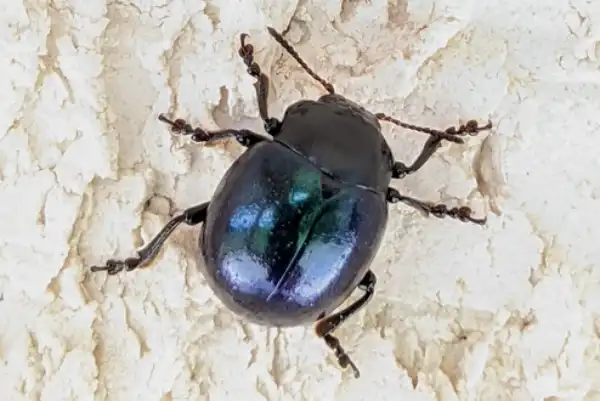
| Scientific name | Leptinotarsa haldemani |
| Size | 5-6 mm |
| Identification | Metallic color sheen |
| Geographical location | Mexico, Central America, and the US states of Arizona, New Mexico, Oklahoma, and Texas |
Haldeman’s green potato beetle, also known as Leptinotarsa haldemani, is a metallic beetle with a black head, antennae, thorax, and legs. Its body shape is domed, and its elytra are usually deep metallic green, sometimes purple or blue.
6. Locust Borer

| Scientific name | Megacyllene robiniae |
| Size | 11-28 mm |
| Identification | Black and yellow striped pattern |
| Geographical location | North America |
Megacyllene robiniae, also known as the locust borer, is a type of a longhorn beetle native to eastern North America and a significant pest of Robinia pseudoacacia, the black locust tree.
Its black and yellow striped pattern makes it easily mistaken for a wasp or bee. Adult beetles are 11 to 28 mm long, with dark brown to black antennae, reddish brown legs, and robust, legless, white larvae.
7. Eastern Hercules beetle
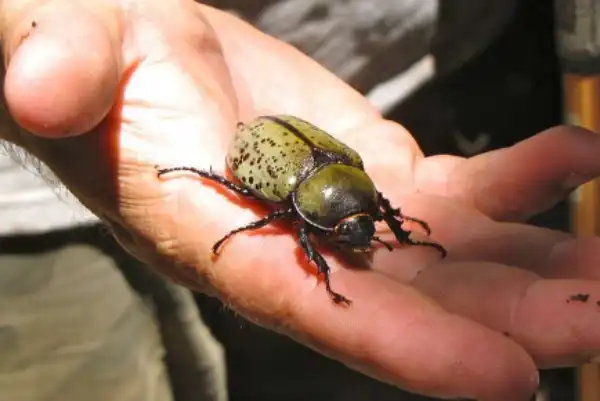
| Scientific name | Dynastes tityus |
| Size | ~60 mm |
| Identification | Pronotal horn and a clypeal horn |
| Geographical location | Eastern United States |
Dynastes tityus, the eastern Hercules beetle, is a species of rhinoceros beetle native to the Eastern United States. The adult beetle has elytra that are green, gray, or tan with black markings, and the entire animal, including the male’s horns, may reach 60 mm in length.
The larvae feed on decaying wood from various trees. Adults are 20–27 millimeters wide, while males are 40–60 mm long, with a pronotal horn and a clypeal horn.
The elytra are green, gray, or tan, with unique patterns of spots. Beetles found in soil or rotten wood often appear dark due to moisture absorbed by the shell.
8. Spotted Cucumber Beetle
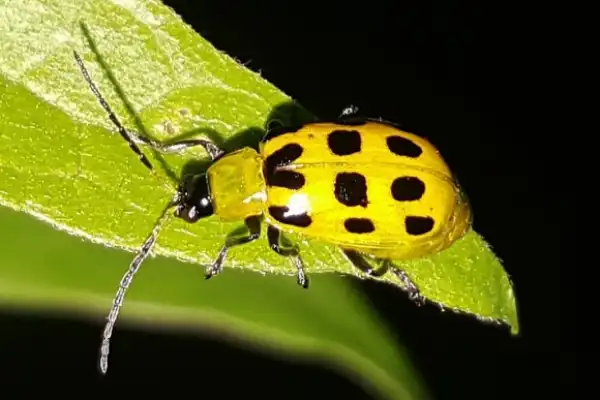
| Scientific name | Diabrotica undecimpunctata |
| Size | ~50 mm |
| Identification | six large black spots |
| Geographical location | North America, and Mexico |
Diabrotica undecimpunctata, also known as the spotted cucumber beetle or southern corn rootworm, is a North American species of cucumber beetle that is a major agricultural pest. It causes damage to crops in both larval and adult stages, feeding on the roots of emerging plants.
In adulthood, the beetles eat the plant’s flowers, leaves, stems, and fruits, spreading diseases like bacterial wilt and mosaic virus. Adult beetles are greenish-yellow with six large black spots and can survive up to 200 days in winter.
9. Ten-lined June beetle
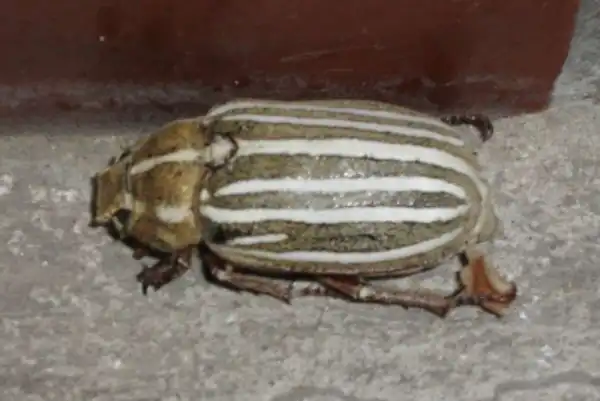
| Scientific name | Polyphylla decemlineata |
| Size | ~38 mm |
| Identification | The underside of the thorax is covered with brownish hairs. |
| Geographical location | western United States and Canada |
The ten-lined June beetle, also known as the watermelon beetle, is a scarab beetle found in the western United States and Canada.
They can be an agricultural pest, affecting various crops due to their larvae feeding on plant roots. Larger than 1.5 inches, they have distinctive antennae used to detect pheromones in females.
Wing covers have four long white stripes and one short stripe each, and the underside of the thorax is covered with brownish hairs.
10. Mexican bean beetle
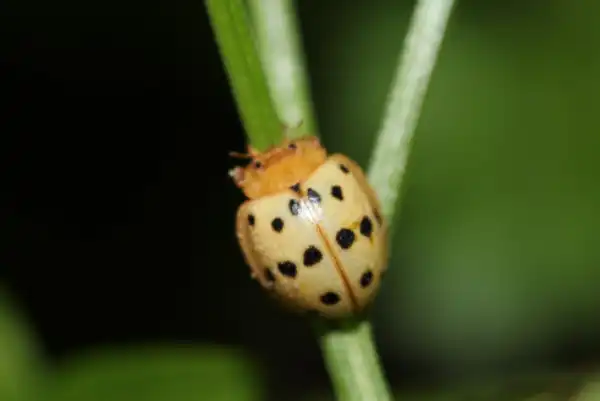
| Scientific name | Epilachna varivestis |
| Size | 6-7 mm |
| Identification | eight black spots on Elytron |
| Geographical location | Mexico and the Eastern United States |
The Mexican bean beetle is a North American lady beetle that feeds on plants and is found in Mexico and the eastern United States. It is abundant in wetter and heavily irrigated areas west of the Rocky Mountains and does not tolerate extremely dry areas.
Adults are oval-shaped, 6 to 7 millimeters long, and have eight black spots on each elytron. Adult color ranges from bright red to rusty brown to golden yellow.
11. Bean Leaf Beetle
| Scientific name | Cerotoma trifurcata |
| Size | 3.5-5.5 mm |
| Identification | black band around the edges of the elytra |
| Geographical location | Eastern and West United States |
Cerotoma trifurcata, also known as the bean leaf beetle, is a species of beetle found in the Eastern and Western United States. Adult beetles are 3.5–5.5 millimeters long and have a punctated elytron in their posterior region.
Morphs can be light gray, yellow, brown, orange, or red. The elytra have a black triangle behind the thorax and six additional black spots with a black band around the edges.
12. Six-spotted tiger beetles
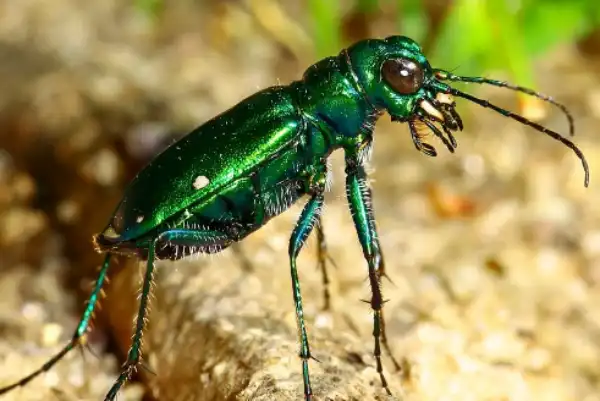
| Scientific name | Cicindela sexguttata |
| Size | 12–14 mm |
| Identification | metallic-blue-green elytra |
| Geographical location | eastern United States and southeastern Canada |
The six-spotted tiger beetle is also known as the six-spotted green tiger beetle. It is known for its bright green color and flight pattern, and it is largely harmless to humans. The adult beetle measures 12–14 mm in length and has long legs.
The beetles are voracious predators of small arthropods but do not bite humans unless handled. The common name and species name refer to the six small white spots on the beetle’s metallic-green to metallic-blue-green elytra.
The female lays her eggs in sandy patches, and the larvae burrow into the ground after hatching. The larvae develop as larvae for about one year before pupating, and the insect has a total lifespan of just under five years.
13. Banded cucumber beetle
| Scientific name | Diabrotica balteata |
| Size | 5-6 mm |
| Identification | Black thorax |
| Geographical location | the United States, Colombia, Venezuela, and Cuba |
Diabrotica balteata is a species of cucumber beetle, also known as the banded cucumber beetle, found in the Americas, including the United States, Colombia, Venezuela, and Cuba.
It is a pest of various agricultural crops and is 5–6 millimeters long with a redhead and black thorax. The elytra are yellow and marked with three transverse bands in shades of green or blue-green.
14. Striped cucumber beetle
| Scientific name | Acalymma vittatum |
| Size | ~5 mm |
| Identification | brown-yellow elytra covering its abdomen |
| Geographical location | Eastern North America and the Rocky Mountains |
Acalymma vittatum, also known as the striped cucumber beetle, is a pest of cucurbit crops in both larval and adult stages. It is found in eastern North America and the Rocky Mountains.
It is replaced by Acalymma trivittatum in the west, which has grayish or pale white elytra. The beetle is small, about half a centimeter in length, and has brown-yellow elytra covering its abdomen.
It resembles the western corn rootworm, Diabrotica virgifera, but has a black ventral abdominal surface and yellow elytra.
15. Lebia grandis
| Scientific name | Lebia grandis |
| Size | 8.5-10.5 cm |
| Identification | Black abdomen |
| Geographical location | North America |
Lebia grandis is a North American ground beetle and a specialist predator of Colorado potato beetle eggs and larvae. It is the largest species in its genus and is about one centimeter long.
Its features include a rusty orange head, thorax, legs, black abdomen, and an iridescent blue or purple luster to the dark-colored elytra. The elytra is wider but shorter than the posteriorly protruding abdomen.
Conclusion:
These are some of the beautiful, colorful beetles you might never have seen. If you want to know more about other kinds of animals, insects, and birds, Any kind of creature that belongs to the Animalia kingdom should join our journey on HowItSee.
Reference:
- Wikipedia
- Insect identification
- Bugguide
Also Read:

As a content writer, I like to write about different niches. I have a curiosity about nature and animals. And like to learn about them. Through my writing, I like to share my experience and knowledge with you. I hope you are enjoying it too.
